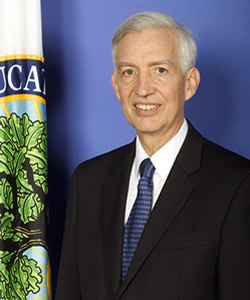President Obama came to office in 2008 when the immediate rush of emotions following the terrorist attacks of September 11, 2001 had subsided. Yet, he recognized the need to bring national leadership to healing the nation across faith lines. He inherited an organization created by President George W. Bush called the Faith-based Initiative. Through executive orders, Bush established a White House office and satellite offices in agencies across the government.
One of Obama’s first actions was to amend the executive orders in several critical ways:
- He renamed the office to White House Office of Faith-based and Neighborhood Partnerships.
- He made the focus of the work the development of partnerships rather than a funding source for faith groups.
- He established an advisory council that had representatives from across faith traditions to recommend priorities for the office.
Obama also named the young and energetic Joshua DuBois to lead this work. All of these actions were important for the critical impact that the office had on the nation in creating and supporting interfaith cooperation and understanding.
First, renaming the initiative to include not just faith-based groups but also neighborhood organizations provided a broader context for work that happens in communities. Rather than diminish the role of faith-based organizations, with this renaming President Obama lifted up faith-based organizations in their role as part of the community. Following 9/11, this made a clear statement that Muslim, Hindu, Buddhist, Jewish, Christian, and other congregations are part of strong communities and a strong nation.
Second, the president ended all funding that passed through various agencies. The move was partly in response to charges that the Bush Administration had used funding to reward political supporters. Sometimes the White House Office helped local groups identify funding from the federal government to support projects. More often the partnerships involved working together for a common purpose like the project described more fully below.
Third, Obama invited faith and community leaders from across the spectrum to join an advisory council that recommended priorities for the work of the Faith-based and Neighborhood Partnerships Office. The council included Christians, Jews, Muslims, Hindus, and secular community organizers. The advisory council was a post-9/11 working group committed to developing multi-faith work at the national level. The first advisory council was chaired by Melissa Rogers, who later followed DuBois as the director of the White House office.
In November 2009 I joined the Obama administration as a senior advisor in the Faith-based and Neighborhood Partnerships Center at the Department of Education. I was invited to join a weekly phone meeting to discuss the establishment of an interfaith project on college campuses. Eboo Patel was a member of the advisory council and had been instrumental in developing a proposal that President Obama accepted to establish an initiative called the
President’s Interfaith and Community Service Campus Challenge. This project illustrates how a post-9/11 federal project worked in partnership with others to advance interfaith cooperation and understanding.
With the president’s green light to move ahead, we started designing a program. DuBois and his two assistants in the White House office, John Kelly and Mara Vanderslice, worked with lawyers in the White House to determine how we could legally collect information from colleges and universities that initiated or expanded programs in interfaith/community service. We wanted to be able to document responses to the President’s Challenge, but the Paperwork Reduction Act required that we follow certain protocols. It was finally worked out that we would ask institutions of higher education to send reports on their responses to the White House. The White House would then forward them to the Department of Education where the office I worked in would compile them. We also composed a letter for President Obama to send to the presidents of all institutions of higher education in the country. In 2010 everything was in place and the President’s Challenge was mailed. To our amazement, 279 institutions responded. Since then over 500 schools have participated by offering opportunities for student of different faiths to engage in community service together.
In 2015
a partnership with Georgetown University's Berkley Center and Hartford Seminary made it possible to include people from around the world with commitments to interfaith/service at what had become an annual gathering.
While the President’s Challenge was not a direct response to the September 11 attacks, it grew out of a commitment on the part of the president to support the full participation of people of all faiths in our life as a nation.

